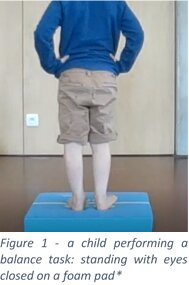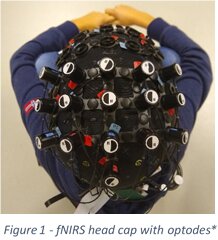Brain activity to understand balance control and control of walking
Adequate balance control is necessary in all types of daily life activities. For example when you walk in the park, you have to avoid a branch that fell of a tree in order not to stumble. Or think of when a person throws you a ball while playing a game of volleyball, you need to prepare your body not to fall when you catch it. Unfortunately, many neurological disorders affecting children or adults, such as cerebral palsy, Developmental Coordination Disorder, Parkinson’s Disease or stroke, impede adequate balance control making daily life activities more challenging or even impossible (1)

It is important to know which underlying system is causing these balance difficulties in an individual in order to target this correctly during physiotherapeutic treatment. Research on functional balance performance (1, 2) or on biomechanical performance measures, such as body sway or muscle activity (3), have already provided us with a better understanding of what is underlying possible balance-related problems. (4) However, when only looking at performance measures, the true neural controlprocesses ensuring adequate balance performance remain a black box. (5)

These neural control processes can be investigated with a variety of brain imaging techniques. Until present most brain imaging research on balance mainly include techniques such as fMRI, PET and EEG measurements, but these techniques lack information on real-time brain activity registered during balance and walking tasks. (5, 6) However with functional Near-Infrared Spectroscopy or fNIRS it now is possible to explore cortical brain activity simultaneously while a person is moving freely. In the past decades fNIRS has revolutionized walking and balance research because of the safe, user-friendly and portable technique (Figure 2). (6) With fNIRS, assessing brain activity during outdoor activities is possible and it can be used in either infants, children and adults. Based on blood-oxygen levels, we know whether the region of interest is more or less active during a task compared to a baseline measurement. This way we get real-time information on (a)typical brain activity during the balance or walking task. (6, 7)
Associations between this neural control and actual performance, such as body sway or muscle activation patterns, are important to consider since they can provide us with further insight into the specific nature of balance control and balance difficulties. (5) These insights will in turn result in more adequate treatment effects and consequently a better quality of life. (1, 2, 7)
Clinical practice and future directions?
Currently the fNIRS technique is only used for research purposes, however fNIRS is a promising tool to aid balance rehabilitation in several scenarios in the near future. Think of scenarios where fNIRS is used as a neurofeedbacktool to aid balance training sessions by providing immediate feedback of the activity of the deficient brain region; or where fNIRS is a monitoring tool to assess treatment effects of balance training. This way, fNIRS will help therapists to provide a more individualized therapy and subsequently optimizing efficacy of physiotherapeutic treatment of balance problems. (8, 9)
Do you want to know more about the use, specifications and methodological considerations? Do not hesitate to contact me or check the literature list.
Written by Charlotte Johnson, PhD student
*Photos are personal property of Charlotte Johnson
1. Horak FB. Postural orientation and equilibrium: what do we need to know about neural control of balance to prevent falls? Age Ageing. 2006;35 Suppl 2:ii7-ii11.
2. Horak FB, Wrisley DM, Frank J. The Balance Evaluation Systems Test (BESTest) to differentiate balance deficits. Phys Ther. 2009;89(5):484-98.
3. Winter DA. Human balance and posture control during standing and walking. Gait & posture. 1995;3(4):193-214.
4. Sousa AS, Silva A, Tavares JMR. Biomechanical and neurophysiological mechanisms related to postural control and efficiency of movement: a review. Somatosensory & motor research. 2012;29(4):131-43.
5. Dijkstra BW, Bekkers EM, Gilat M, de Rond V, Hardwick RM, Nieuwboer A. Functional neuroimaging of human postural control: a systematic review with meta-analysis. Neurosci Biobehav Rev. 2020.
6. Menant JC, Maidan I, Alcock L, Al-Yahya E, Cerasa A, Clark DJ, et al. A consensus guide to using functional near-infrared spectroscopy in posture and gait research. Gait & Posture. 2020;82:254-65.
7. Herold F, Wiegel P, Scholkmann F, Thiers A, Hamacher D, Schega L. Functional near-infrared spectroscopy in movement science: a systematic review on cortical activity in postural and walking tasks. Neurophotonics. 2017;4(4):041403.
8. Cutini S, Brigadoi S. Unleashing the future potential of functional near-infrared spectroscopy in brain sciences. Journal of Neuroscience Methods. 2014;232:152-6.
9. Berger A, Horst F, Müller S, Steinberg F, Doppelmayr M. Current state and future prospects of EEG and fNIRS in robot-assisted gait rehabilitation: a brief review. Frontiers in human neuroscience. 2019;13:172.